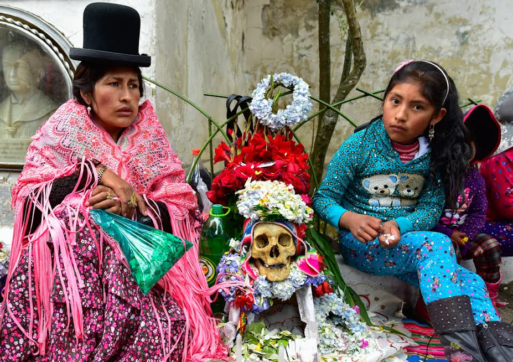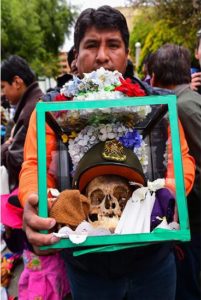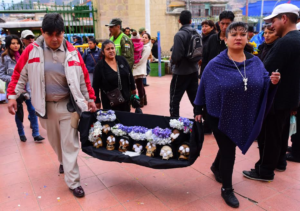Our own practices regarding death in the West are so familiar to us that other cultures’ activities related to the dead may seem grotesque or bizarre. But in discussing death, we must be open to different beliefs and ideas. In Bolivia, a different kind of relationship forged between the living and the dead takes the form of “ñatitas.”

Credit: orderofthegooddeath.com
Ñatitas are, to put it bluntly, human skulls. The word “ñatitas” translates roughly to “flat noses,” or, “little pug-nosed ones,” according to Caitlin Doughty, who wrote about ñatitas in her book, “From Here to Eternity.”
Most ñatitas are not necessarily skulls that came from relatives or friends. Owners may procure the skulls from medical schools, overcrowded cemeteries, archaeological sites or many other possible locations. So they are not always kept around to remember loved ones who have died.
Every ñatita is believed to have a supernatural “specialty,” each a relic to pray to for help or good luck related to its subject of expertise. One woman Doughty met during her trip to La Paz, for instance, houses 67 ñatitas in her home.
Each has its own personality and unique wish-granting function. Carlitos, for example, is the skull you’d visit for anything health-related. Cecilia aids students studying at university. One of the more powerful skulls in the woman’s home, Oscar, helped her family recover after they’d lost their home and had no money. According to their owners, ñatitas can work miracles.
Ñatitas and their living comrades form special relationships. However, as with human relations, not all natitas and their owners “get along.”
“Everyone has a personality, and in some cases it might not be a good fit between a person and a skull,” said Paul Koudounaris, an art historian who has attended the annual Fiesta de las Ñatitas in La Paz since 2007 and is a friend of Doughty’s. “People will say, ‘I got this skull from my cousin who didn’t get along with it, but I’m getting along with it very well.’”
The Ñatitas Backstory
Ñatitas become a part of the family household for people who adhere to the tradition. This is not to say, however, that a majority of Bolivians keep skulls in their homes. At least, not always openly. The practice has been kept alive many times by surreptitious means. The staying-power of ñatitas is attributable to the Aymara people, the second-largest indigenous group in Bolivia.

Credit: smithsonianmag.com
The Aymara regard death as a transition to another realm of existence. The ñatitas can house the souls of their former occupants, but this may not always be the case. This idea follows from the ways in which the Aymara people conceive of the human spirit.
According to Koudounaris, the Aymara believe a person’s spirit is comprised of numerous forms of “ajayu” (roughly translated as soul). There are varying levels of “ajayu” that complete a person’s pallette of attributes, and after death these may disperse into differing entities. So the spirit housed inside a ñatita may not be the same as the person whose skull it was in life.
The Aymaran practice of praying to and keeping human skulls in the home has been met with some resistance in Bolivia, particularly by the Catholic Church. Ñatitas and rituals surrounding skulls represented sorcery and witchcraft to the Spaniards who arrived in Bolivia in the 16th century.
Even until recently, the Church has not been entirely welcoming of the ñatita tradition. For many years, the Aymaran people were considered second-class, and even into the 20th century urban Aymaran women, known as “cholitas,” were not allowed into certain government offices, restaurants and buses.
Discrimination against Aymaran people still exists today, but their culture is becoming more accepted as the years go by. Cholitas have reclaimed their identities, particularly their traditional outfits of multi-layered skirts, bowler hats and shawls. As Aymaran culture is becoming more accepted, so too are ñatitas.
Fiesta de las Ñatitas
The Fiesta de las Ñatitas is an annual celebration held in La Paz at the city’s General Cemetery. Thousands of people line the cemetery’s pathways and bring their ñatitas in a multitude of fashions.

Credit: orderofthegooddeath.com
Some skulls are housed in glass cases, others in wooden boxes and some without vessels. Many are adorned with flowers; some wear hats; and still others rock sunglasses, jewels and smoke cigarettes. As mentioned earlier, each ñatita has its own style and personality.
The Fiesta de las Ñatitas is a celebration of all ñatitas and represents a chance for their families to say, “thank you.” It’s the ñatitas’ day to celebrate. Since the Fiesta has gained popularity over the years, even the Catholic Church has come around, and recently the ñatitas have been granted blessings by priests during the event.
The skulls spend the day of the Fiesta displayed throughout the cemetery, covered in offerings and kept as the focal point of attention. After the sun goes down, parties called “prestas” pop up nearby, and the celebration goes into the night.
To outsiders, the natita tradition of Bolivia may seem morbid. However for many Bolivians, these cherished skulls are part of the family, offering help and hope in times of need.

 Ñatitas Offer Bolivians Blessings and Hope
Ñatitas Offer Bolivians Blessings and Hope


 “As Tears Go By” by Marianne Faithfull
“As Tears Go By” by Marianne Faithfull

 Funeral Favors Offer Visitors a Tangible Memento
Funeral Favors Offer Visitors a Tangible Memento















